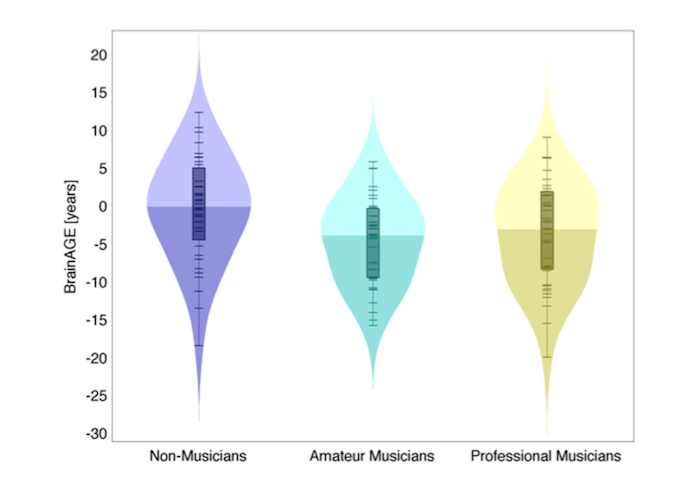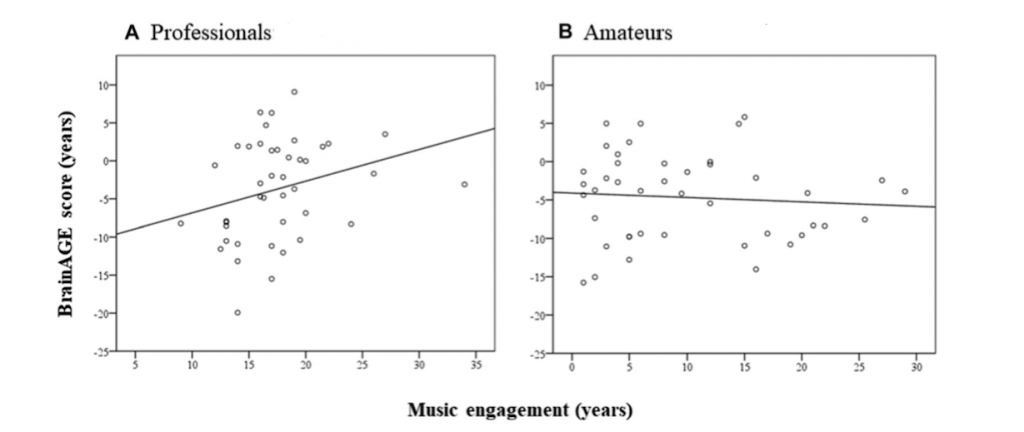Title of paper under discussion
Keeping brains young with making music
Authors
Lars Rogenmoser, Julius Kernbach, Gottfried Schlaug and Christian Gaser
Journal
Brain Structure and Function (2018) 223:297–305
Link to paper (free access)
Overview
Already known for its effect on brain development and its potential to help brain rehabilitation, might music-making have a further benefit: an age-protecting effect on the brain? This question was addressed in investigations carried out at Harvard Medical School, using MRI scans on the brains of non-musicians, amateur musicians and professional musicians. Using a machine-learning algorithm called “BrainAGE” – which predicts a brain’s age according to how old it “looks” in an MRI scan – amateur musicians’ brains were on average 4.5 years “younger-looking” than their real age, with professional musicians close behind on 3.7 years. Interestingly, the more experienced the professional the less their brain was “youthened”, whereas more experienced amateurs enjoyed no such lessening of this “brain-youthening” effect. The authors suggest that “intense music-making at a professional level” could involve “stress-related interferences” and a “less enriched environment” not suffered by amateurs, possibly “somewhat diminishing the otherwise positive effect of music-making”.
BrainAGE algorithm
BrainAGE technology involves a “machine-learning classification algorithm derived from a training sample”. In short, this means that hundreds of MRI brains scans – on brains of known ages – are fed into a computer program that thereby “learns” to match the “look” of a brain to its real age. Having gone through this training, the programme can then be fed new MRI brain scans and asked to predict their ages. In this present study the algorithm was “trained” using 631 brain scans from a publicly available database, brains aged from 20 to 70 years old. The MRI scans from the participants in the study (non-musicians, amateur musicians and professional musicians) were then fed into the algorithm and were age-predicted accordingly. The difference between the predicted age and the real age is called the “brainAGE score” – a positive score describing a brain that “looks older” than it actually is, and a negative score celebrating a brain that “looks younger” than reality.
Method
38 non-musicians, 45 amateur musicians and 42 professional musicians were recruited – all three groups were of comparable age range, male-female ratio, education and sportiness. Each participant volunteered to have their brain scanned in an anatomical MRI scanner, and each scan was fed into the brainAGE program. In this way each brain was given a “brainAGE score” being the difference between the age predicted by the computer and its real (chronological) age.
Results

The graph above plots the distribution of brainAGEs – the difference between the “look” of the brain’s age and its real age – within all three groups. The shading transition marks the average (median) reading of each group (with the short horizontal lines marking the individual readings and the box marking the ‘middle half’ of the data).
On average the amateur musicians boasted a brainAGE score of -4.51 years, while professionals scored an average of -3.7 years, results suggesting “a general age-decelerating effect of music-making on the brain”.
Further analysis involved looking at “the relationship between brainAGE scores and the number of years involved in musical activities for the professional (A) and amateur (B) groups”, plotted below:

The gradients of the lines suggest that there while there is no significant correlation between music-making experience and their brainAGE score in amateurs (graph B), there is a small positive correlation in the professional group (graph A), meaning that “with increasing number of years of music-making, the professional musician group might have less of an age-decelerating effect”.
Discussion
Perhaps unsurprisingly, given a wealth of previous research demonstrating the effect of music-making on enhancing “neural and synaptic activity as well as regional cerebral blood flow and metabolism”, this study confirms that “making music can modulate the effect of aging on the brain”.
The authors detail brain changes that occur if sensorimotor activities (such as music-making) are “learned and practised over a long time”, changes such as “an increase in myelination [nerve cell insulation]…an increase in glial [support] cells and [blood] capillary density, an increase in the density of dendritic spines [connection points between nerve cells], and possibly even new brain cells, leading to an increase in grey matter volume and density” – all of which could in some way be ‘visible’ to the MRI scanner and hence help to lower the brainAGE score. Other studies make the claim that this “gain in brain structure constitutes a “reserve” function that buffers against brain pathology and age-related atrophy”.
The authors pay particular attention to the frontal lobe, an area of the brain “that is strongly affected by any degeneration process relatively early on”. They remind us that the frontal lobe “plays an important role in music-making activities” and that if, as suspected, such activities stimulate and maintain an enriched blood supply, cell support network and neural connections to this area then it will be better protected from “aging-related structural changes”.
Finally Rogenmoser and his colleagues turn their attention to the finding that “making music has a stronger age-decelerating effect when it is not performed as a main profession, but as a leisure or extracurricular activity..”. They suggest that the life of a professional musician, involving “highly specialised repetitive sensorimotor activities for many hours per day as well as during stressful public performance periods” might result in a “less enriched environment”, and even negative health effects. They add that “chronic stress has been shown to accelerate the atrophying process in the brain”, and that “the highly competitive situation professional musicians are usually exposed to promotes a stressful lifestyle with dysfunctional manifestations as reflected in higher prevalence rates of anxiety, depression, and sleep disturbance.”
In a nutshell, the authors ask us to consider the possibility that amateurs treat music-making as an “enrichment activity”, with study after study (on rats let alone humans) showing a correlation between environmental enrichment and brain development at the micro and macro level. But that “at a professional level, intense music-making activities could also be associated with a stress-related interference and possibly create a less enriched environment than that of amateur musicians possibly somewhat diminishing the otherwise positive effect of instrumental music-making”.
Coda
The Beatles
What a fascinating study! I have been an amateur musician since childhood. Singing in choirs, playing piano and at the age of 72 taking up the Tenor Horn and joining a Brass Band! My family think I am much sharper than I was ten years ago so maybe my brain us only 71 whilst in fact I am 75!!